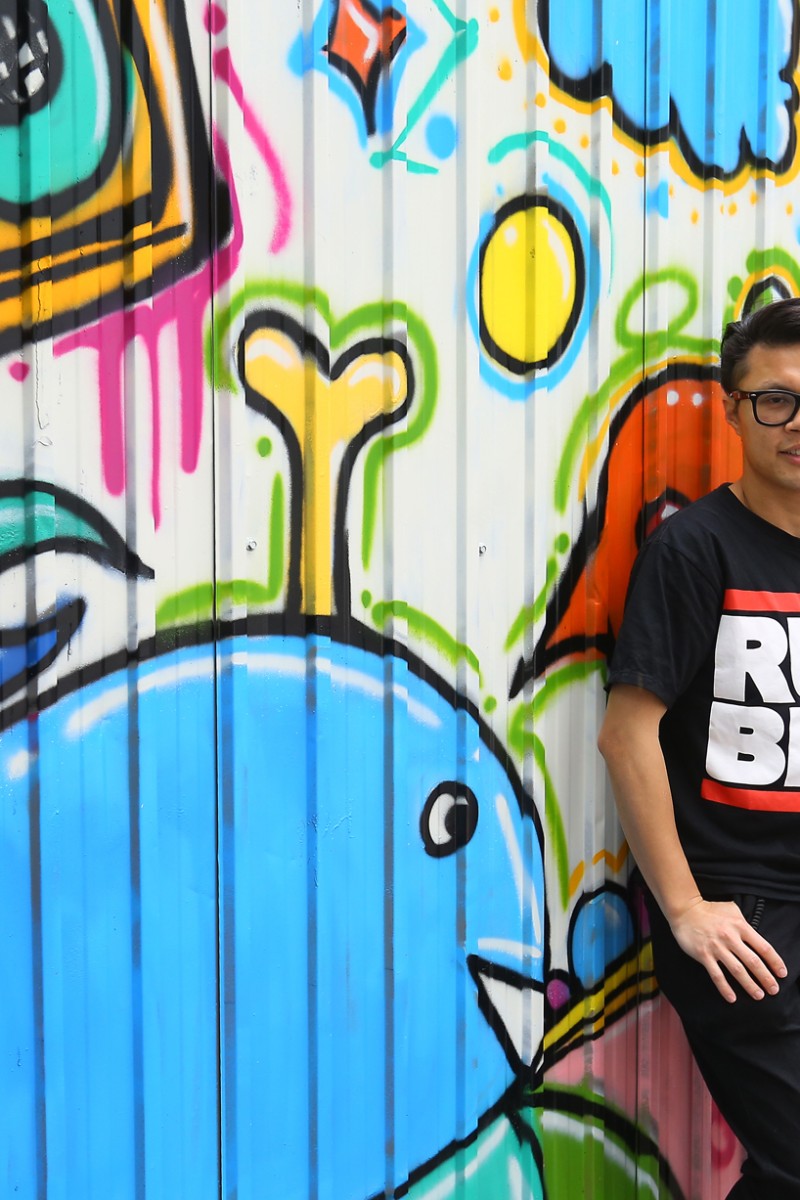
Revitalising Kwun Tong one back alley at a time
Kwun Tong is changing, and social enterprise RunOurCity hopes to be a part of that change, by using street art
 Street artist Pantone C (left) and RunOurCity's co-founder and CEO Andes Leung
Street artist Pantone C (left) and RunOurCity's co-founder and CEO Andes LeungBehind the bustling main streets in Kwun Tong lie a number of dark, run-down alleys.
But social enterprise RunOurCity hopes to change the bleak image of Kwun Tong's back streets by introducing street art. Working with the government's Energising Kowloon East Office (EKEO), RunOurCity is negotiating with property owners for permission to commission artists to jazz up their narrow streets.
Exiting the MTR station at Kwun Tong fire station, you are greeted with one of the four back streets that have been revitalised. A riot of colour fills every inch of the wall outside the fire station, spray painted by local artist Pantone C and his students. Among the many random elements, there's a whale, a fire extinguisher, some speakers, the letters "HK" and a huge doughnut. "I want the area to be more upbeat," says the artist. Cogs and a radio indicate Kwun Tong's industrial nature, while marine elements such as shells and fish hint at the nearby pier.
There's also a crocodile, because the office for shirtmaker Crocodile is just round the corner. Before the office was built in 2009, a shirt factory stood in its place. Students at the Jockey Club Design Institute for Social Innovation nicknamed the alley "Da Baan Lane". In English, "da baan" means pattern-making, an important process in shirt production.
In another alley, a series of neon lights have been put up as an art installation because the area used to manufacture electronic components. Heading over to the alley linking Hing Yip Street and Hung To Road, you'll see several portraits by Bo Law and overseas artists Renny Cheng from Malaysia and Addison Karl from the United States. Law's work is a hand-drawn piece showing a man holding a baby. One of Addison Karl's spray can portraits is inspired by a local fisherman he met in Hong Kong.
"There's urban decay in this area, so we need to beautify it," says Pantone C. "Street art, or public art, is very effective in revitalising the city. Usually these areas are prone to high crime rates, but with art, it energises the area and brings people in. Naturally, crime will then decrease." Unlike many street artists, Pantone C says he avoids spraying skulls or darker content. "People won't like it. Public art should be what most people like."
Back in the 50s, Kwun Tong was an important industrial hub in Hong Kong. As the manufacturing sector declined, the government has been replacing industrial buildings with commercial ones.
"It's a really exciting place to be," says Andes Leung, director of RunOurCity. "Kwun Tong has a spirit of entrepreneurship about it. It's in the midst of transformation. You see a mix of old and new buildings, of the grassroots and the middle-class. Its back streets are rich with stories. There's lots to be inspired by."
Leung hopes to introduce youngsters to the area by organising guided runs. "We encourage youngsters to run because it increases their self-confidence. This is in line with Kwun Tong's industrious spirit. The spirit of not being defeated," he says.
Groups of up to 25 people can join guided runs organised by RunOurCity. Volunteers will lead participants on a 3.5km run through the district's back streets to enjoy the artwork. They will stop at points to allow time for photo-taking. "It's not a race, it's an experiential run," says Leung.
Before the launch of the first run on March 21, though, some of the artwork was vandalised. There were also complaints on the internet about the government spending a huge chunk of money on "ugly" artwork.
The sad nature of street art is there's no guarantee it'll last. "It's a pity [that street art gets covered]," says Pantone C. "But some people use it to vent. You can't control that."
